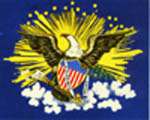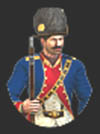

 |
The Legion of the United States |  |
|---|
After the Revolutionary War, the Continental Army was quickly disbanded as part of the American distrust of standing armies, and irregular state militias became the new nation's only ground army, with the exception of one regiment to guard the Western Frontier and one battery of artillery guarding West Point's arsenal. A continuing conflict with the indians of the "Northwest Territory" caused the military leaders and Congress to realize a pressing need for a standing army. The Northwest Territory included all of the land generally west of Pennsylvania, northwest of the Ohio River, and east of the Mississippi River. It encompassed what would become the states of Ohio, Indiana, Illinois, Michigan, and Wisconsin, as well as the northeastern part of Minnesota. In 1791, congress decided to recruit and train a "Legion" which would combine typical military units of the day (cavalry, heavy and light infantry, artillery) into an efficient army force and allow the individual units to be utilized as separate entities when needed. This first standing army of the United States was to be called the "Legion of the United States" and was roughly modeled after the old Roman Legion structure.
The Legion was composed of four "Sub-Legions", each commanded by a brigadier general under the overall command of General Anthony Wayne. These Sub-Legions were self-contained units with two battalions of infantry, a rifle battalion (light infantry used to screen the infantry), a troop of dragoons and a battery of artillery. The Legion received training, concentrated on fighting in a woodland environment, at "Legionville", a frontier fort built by General Wayne in western Pennsylvania. General Wayne also established various forts along his line of march to ensure adequate re-supply, and garrisoned these forts with freshly trained legionnaires. The forts stretched along the Maumee River, from its mouth at present day Toledo, Ohio to present day Fort Wayne, Indiana (named after General Wayne). Officers, sergeants and enlisted personnel were trained to fight on their own in small units being isolated from larger forces. General Wayne's tactics were to fire and move quickly with the light infantry in front supported by heavy infantry. This would deny the enemy the chance to re-load and allow the forces to attack with bayonets. This was an adaption, derived from concepts utilized by the old "Roman Legion", and would prove to be effective in the upcoming confrontation with the indians. By August, 1794, the Legion of the United States had trained for over 25 months becoming an effective, efficient military unitand preparing the "Legionnaires" for an upcoming battle with the indians of the "Northwest Territory" in the attempt to finally regain control and dominance in the area.
The Indian "Confederacy", led by Blue Jacket and Little Turtle, had soundly defeated General Josiah Harmar's militia twice in October, 1790, and General Arthur St. Clair's militia in November, 1791, killing 632 of his 920 men. By June, 1794, Little Turtle had ceded command of the Confederacy to Blue Jacket who was now ready to confront Wayne's Legionnaires. Blue Jacket assumed a defensive position along the Maumee River near a copse of fallen trees and close to British-held Fort Miami. It was hoped that the fallen trees would slow the advance of Wayne's men. On August 20, 1794, Wayne attacked Blue Jacket's position and his superior numbers and superbly trained men quickly began to rout the indians out of their position. With the American dragoons attacking their flank, the Confederacy's warriors fled towards Fort Miami hoping the British would provide protection. However, the commander of Fort Miama, not wishing to start another war with the Americans, had closed the gates. The Confederacy's men fled and Wayne ordered his troops to burn all of the villages and crops in the area and then withdrawal to Fort Greene Ville. On August 3, 1795, as a direct result of the Battle of Fallen Timbers, the Native Americans signed the Treaty of Greene Ville, ending the war with the United States.
In 1796, having lost their indian allies, the British surrendered all of the British forts, including Fort Niagara and Fort Miami. These forts had been illegally maintained within the Northwest Territory in violation of the 1783 Treaty of Paris; due mainly to the fact the United States lacked and army to force them out. The Legion also entered the indian stronghold of Kekionga, the goal of the ill-fated St. Clair campaign. The Legion built strong fortifications in the town and named it Fort Wayne, in honor of their commanding general. This effectively ended the mission for which the Legion was initially formed. After the death of General Anthony Wayne, on December 15, 1796, his second-in-command, Brigadier General James Wilkinson tried to rid the army of the legionary structure set forth by Wayne. Inasmuch, the 1st, 2nd, 3rd and 4th Sub-Legions became the 1st, 2nd, 3rd and 4th Regiments of Infantry of the United States Army.
The structure of the Sub_Legions consisted of 2 battalions of 4 infantry companies each, 1 battalion of 4 rifle companies, 1 light dragoon (cavalry) company, and 1 artillery company. An infantry companywas made up of 1 captain, 1 lieutenant, 1 ensign, 6 sergeants, 6 corporals, 2 musicians, and 81 privates for a total of 98 men. A rifle company was made up the same except on of the musicians was replaced with a private. A dragoon company consisted of 1 captain, 1 lieutenant, 1 cornet, 6 sergeants, 6 corporals, 1 farrier, 1 saddler, 1 trumpeter and 65 privates. The artillery company, as far as can be determined, consisted of 1 major, 1 captain, 2 captain lieutenants, 7 lieutenants, 1 adjutant, 10 sergeants, 12 corporals, 2 bombardiers,; 2 gunners, and 100 matrosses (gunners assistants). Matrosses were armed with muskets and bayonets, as their duties included guarding the guns and wagons on the march. The artillery company consisted of cannon, howitzers, and mortars; the exact number of which couldn't be found in research of this subject. Although the Legion was designed for a contingent of 5.120 men, the most number of men the Legion could maintain on their rolls was approximately 3,300 at any one time. As a result of this the 3rd and 4th Sub-Legions were never fully formed; with the 4th consisting of some infantry companies and approximately 150 mounted Kentucky Volunteers and the 3rd mainly consisting of some infantry and an artillery company. The Legion also employed Choctaw and Chickasaw Indians serving as scouts.
General Wayne decided early on to differentiate his various Sub_Legions by assigning individual unit colors: 1st Sub-Legion: White and Black, 2nd Sub-Legion: Red and White, 3rd Sub-Legion: Buff and Black, and 4th Sub-Legion: Green and White. Today, these basic unit colors are carried on by the infantry units descended for the Sub-Legions. The device worn on the epaulette of the 3rd US Infantry (The Old Guard) shows a black hat with white plume, the colors of the 1st Sub-Legion. The Coat of Arms for the 1st US Infantry shows part of the shield in red in honor of the 2nd Sub-Legion and the Coat of Arms of the 4th US Infantry is green and white in honor of the 4th Sub-Legion.
Back to 2/1 History Page
Back to History Page
Back to Home Page